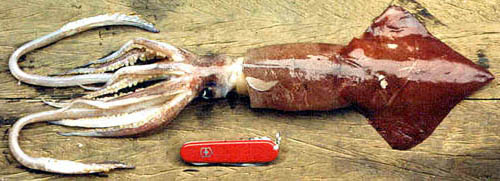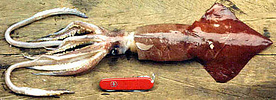Onykia
Michael Vecchione, Richard E. Young, and Kotaro Tsuchiya


This tree diagram shows the relationships between several groups of organisms.
The root of the current tree connects the organisms featured in this tree to their containing group and the rest of the Tree of Life. The basal branching point in the tree represents the ancestor of the other groups in the tree. This ancestor diversified over time into several descendent subgroups, which are represented as internal nodes and terminal taxa to the right.

You can click on the root to travel down the Tree of Life all the way to the root of all Life, and you can click on the names of descendent subgroups to travel up the Tree of Life all the way to individual species.
For more information on ToL tree formatting, please see Interpreting the Tree or Classification. To learn more about phylogenetic trees, please visit our Phylogenetic Biology pages.
close boxIntroduction
Adults of Onykia are medium-sized (275 mm ML) to very large (1600 mm ML) squids which are the largest members of the family. Only two genera of cephalopods, Architeuthis, the true giant squid, and Mesonychoteuthis, a cranchiid squid, grow to greater lengths than some species of Onykia. Species of Onykia are well known from high latitudes. Tropical species, however, are poorly known.
Diagnosis
An onychoteuthid ...
- without gladius visible beneath skin in dorsal midline.
- with 3 occipital folds.
- without suckers on distal portion of club before terminal pad.
Characteristics
- Tentacles
- Clubs of subadults and adults with two series of hooks; suckers limited to carpal cluster and terminal pad.
- Head
- Three occipital folds present (arrows in photograph). Occipital membrane from fold number 3 extends to, or nearly to, nuchal cartilage.
 image info
image info Figure. Lateral view of head showing occipital folds, Onykia sp.(robusta?), 25 mm ML, ca 32°N off southern California, NMNH #542.
- Three occipital folds present (arrows in photograph). Occipital membrane from fold number 3 extends to, or nearly to, nuchal cartilage.
- Funnel
- Funnel groove with inverted Y-shaped ridge in squid over 100 mm ML. This characters is known in O. lonnbergii, O. robusta and O. robsoni. Its presence in other species is uncertain although it appears to be absent in O. ingens and O. knipovitchi.
- Anterior margin of funnel groove rounded.
 image info
image info  image info
image info Figure. Left - Ventrolateral view of the head of O. robusta showing the funnel groove, 160 mm ML. Drawing from Okutani, 1983. Right - Ventral view of head and funnel groove of O. robsoni (?), northeast coast of USA. Photograph by R. Young.
- Mantle
- Dermis of mantle skin with warts or soft wrinkles (except in O. knipovitchi).
- Photophores
- Photophores absent.
- Gladius
- Gladius with long, thick, cartilaginous-like rostrum.
- Long, lanceolate vanes extend into conus field without the narrow, posterior "neck" seen in Onychoteuthis, Ancistroteuthis and Notonykia.
 image info
image info Figure. Ventral view of the gladius of O. ingens with cross-sections and a side view of the conus and rostrum. Drawings from Pfeffer, 1912.
Comments
The rostrum of the gladius is peculiar, not only in its size but in its cartilage-like structure. The drawing in Fig. A shows the conus of the gladius with the rostrum removed (it detaches easily from the gladius). Along side it (Fig. B is a drawing of the removed rostrum. Fig. C shows a scanning electron micrograph cross-section throuh the rostrum at the point of the arrow in Fig. B. Note the spaces, fluid-filled in life, that give the rostrum its cartilage-like consistency.
 image info
image info Figure. Gladius of O. robusta. Drawings and photomicrograph from Toll, 1982. A - Ventral view of the gladius conus. B - Ventral view of the rostrum. C - Scanning electron micrograph of a cross-section of the rostrum.
Species comparisons
| Species | Cross-section of rostrum | Skin sculpture | Fin shape | Number of hooks | Habitat |
|---|---|---|---|---|---|
| O. carriboea | ? | ? | ? | ? | Western tropical/subtropical Atlantic |
| O. ingens | Triangular | Warts | Romboidal | 28 | Subantarctic |
| O. knipovitchi | Triangular | Smooth | Rhomboidal | 20-30 | Antarctic waters |
| O. lonnbergii | Triangular | Warts | Rhomboidal | 25 | Western North Pacific |
| O. robsoni | Triangular | Warts | Sagittate | 26-32 | North of southern subtropical convergence |
| O. robusta | circular | ridges | Sagittate | 30-36 | Temperate, subarctic North Pacific |
Nomenclature
For nearly a century members of this taxa were placed in the genus Moroteuthis. In 1991, Tsuchiya and Okutani demonstrated that species of Onykia Lesueur, 1821, were the young stages of Moroteuthis Verrill, 1881, which placed the latter as a junior synonym of the former. Tsuchiya and Okutani (1991) also demonstrated that "Moroteuthis" japonica (Taki, 1964) and "Moroteuthis" pacifica were growth stages of Onykia robusta. Kubodera et al. 1998, state that Onykia indica Okutani, 1981 is probably the young of some known species of Onykia. These authors also declared Onykia aequatorialis (Thiele, 1920) a nomen dubium.
Life History
Young Onykia, like the ca 10 mm ML squid in the photograph (below left), are common members of the oceanic neuston. They are often associated with floating debris and have a bluish iridescence. Even at 25 mm ML (below right) some species may still be neustonic.
 image info
image infoFigure. Left - Side view of a juvenile Onykia sp., ca. 1 cm ML, Hawaiian waters, live. Right - Side view of a juvenile Onykia sp., 25 mm ML, off southern California (NMNH #542), preserved. Photographs by R. Young.
The paralarvae (Figs. A-C below) have a distinctive appearance: They are broad and have a characteristic line of large dorsal mantle chromatophores whose widths increase posteriorly. Small paralarvae often are observed in preserved samples with the head mostly withdrawn into the mantle cavity as shown in Fig. A.
 image info
image infoFigure. Ventral and dorsal views of paralarvae and an early juvenile of Onykia sp. A - 1.7 mm ML paralarva. B - 2.7 mm ML paralarva. C - 3.4 mm ML paralarva. D - 5.6 mm ML juvenile. A-C show paralarvae with contracted anterior mantle margins which are commonly observed in preserved paralarvae. These growth stages were taken from plankton tows in Hawaiian waters. The adult is unknown. The scale bar is 1 mm.
References
Kubodera, T., U. Piatkowski, T. Okutani and M.R. Clarke. 1998. Taxonomy and Zoogeography of the Family Onychoteuthidae (Cephalopoda: Oegopsida). Smithsonian Contributions to Zoology, No. 586: 277-291.
Okutani, T. 1983. A new species of an oceanic squid, Moroteuthis pacifica from the North Pacific (Cephalopoda: Onychoteuthidae). Bull. Nat. Sci. Mus., Ser. A (Zoology), 9:105-113.
Pfeffer, G. 1912. Die Cephalopoden der Plankton-Expedition. Ergebnisse der Plankton-Expedition der Humboldt-Stiftung. 2: 1-815.
Toll, R.B. 1982. The comparative morphology of the gladius in the Order Teuthoidea (Mollusca: Cephalopoda) in relation to systematics and phylogeny. PhD. Dissertation, University of Miami, 390 pp.
Tsuchiya, K., and T. Okutani. 1991. Growth Stages of Moroteuthis robusta (Verrill, 1881) with the Re-evaluation of the Genus. Bulletin of Marine Science, 49(1/2):137-147.
About This Page
National Marine Fisheries Service
Systematics Laboratory
National Museum of Natural History
Washington, D. C. 20560
USA
Richard E. Young
Dept of Oceanography
University of Hawaii
Honolulu, Hawaii 96822
USA
Tokyo University of Fisheries, Konan, Minato, Tokyo
Page copyright © 2003 , Richard E. Young, and
Citing this page:
Vecchione, Michael, Young, Richard E., and Tsuchiya, Kotaro. 2003. Onykia . Version 01 January 2003 (under construction). http://tolweb.org/Onykia/19956/2003.01.01 in The Tree of Life Web Project, http://tolweb.org/










